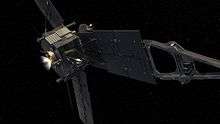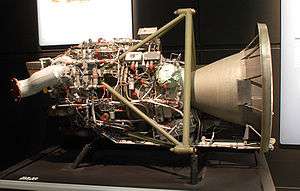LEROS
LEROS is a family of chemical rocket engines manufactured by Nammo[1] at Westcott, Buckinghamshire, United Kingdom. LEROS engines have been used as primary apogee engines for telecommunications satellites such as the Lockheed Martin A2100[2] as well as deep space missions such as Juno.[3]
The family of engines derives from the LEROS 1 which was developed and qualified in the 1990s by Royal Ordnance. The in-space propulsion business was acquired by British Aerospace, then had a sequence of owners including American Pacific Corporation, Moog[4] (from 2012) and Nammo (2017). The LEROS engines are made of niobium alloy, which is traditionally used for liquid rocket engines such as the attitude control thrusters of the Apollo Lunar Module. As of 2011, more than 70 LEROS 1 series engines had been flown successfully.[5]
| Engine | Propellant | Thrust | Isp | Comments |
|---|---|---|---|---|
| LEROS 1c[6] | Hydrazine / MON | 460 N | 325 | |
| LEROS 1b | Hydrazine / MON | 635 N | 318 | |
| LEROS 2b | MMH / MON | 407 N | 318 | |
| LEROS 4 | MMH / MON | 1100 N | 323[7] | Developed c.2014 for European Space Agency's (ESA) Mars Robotic Exploration Program[8] |
Uses

LEROS engines have been used on a number of NASA and other space agency missions:
- NEAR Shoemaker (Near Earth Asteroid Rendezvous)
- Mars Global Surveyor [9]
- Mercury Messenger [10]
- Juno
- JCSAT-13 [11]
- Sirius 4
- Nimiq 1 [12]
- SBIRS GEO 1 and GEO 2 [13][14]
- Intelsat 33e[15]
- Beresheet lunar lander[16]
There have been helium check valve problems on Juno leading to postponed maneuvers, and a failure after the first burn on Intelsat 33e requiring backup low-thrust jets to be used to bring the satellite to its intended orbit.[15]
References
- "Nammo acquires Moog's European In-Space Propulsion businesses". Mynewsdesk. 12 June 2017. Retrieved 28 June 2018.
- Spaceflight Now - LEROS 1c First Firing
- Amos, Jonathan (4 September 2012). "Juno Jupiter probe gets British boost". BBC News. Retrieved 5 July 2016.
- "Moog Space & Defence Group". moog.co.uk. Archived from the original on 22 February 2017.
- Corporation, American Pacific. "LEROS Engine Propels the Juno Spacecraft on Its Historic Voyage to Jupiter". www.prnewswire.com. Retrieved 2018-06-28.
- Moog ISP Apogee/Upper Stage Thrusters Archived 2014-11-29 at the Wayback Machine
- Naicker, Lolan (May 2014). "An overview of development model testing for the LEROS 4 High Thrust Apogee Engine" (PDF). lolannaicker.com. Retrieved 28 June 2018.
- Werner, Debra (15 July 2013). "Moog Sees Higher-thrust Liquid Propellant Engine as Right Fit for Mars Missions". SpaceNews. Retrieved 5 July 2016.
- Astronautix - Mars Global Surveyor Archived 2009-08-10 at the Wayback Machine
- Spacenewsfeed - NASA Mercury Messenger Orbit Insertion
- Spaceflight101 - Ariane 5 Flight VA206 Archived 2013-02-12 at the Wayback Machine
- Astronautix - A2100 Platform Archived 2013-07-19 at the Wayback Machine
- Skyrocket - SBIRS Geo 1
- Spaceflight101 - Atlas V SBIRS Geo 2 Launch Archived 2014-09-13 at the Wayback Machine
- Stephen Clark (30 January 2017). "Intelsat satellite in service after overcoming engine trouble". Spaceflight Now. Retrieved 31 January 2017.
- Jonathan Amos (21 February 2019). "Israel's Beresheet robot sets its sights on the Moon". BBC News Online.
